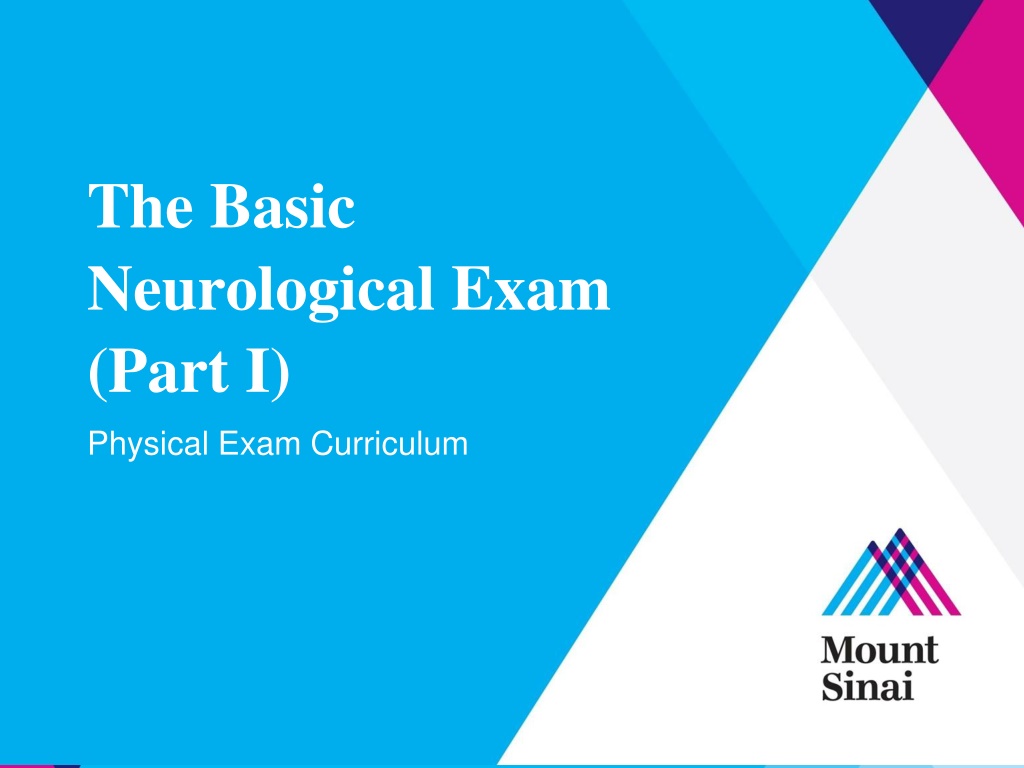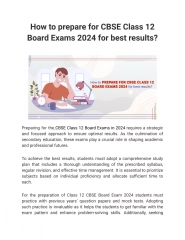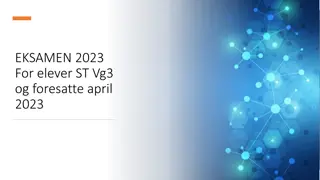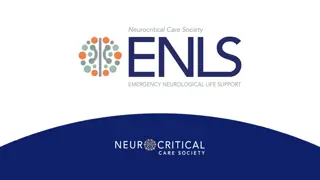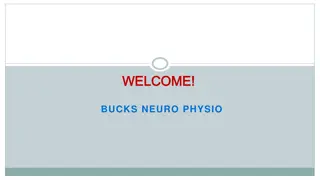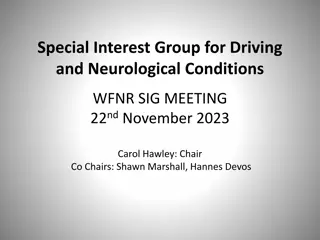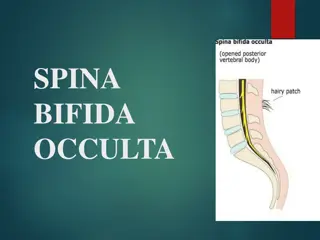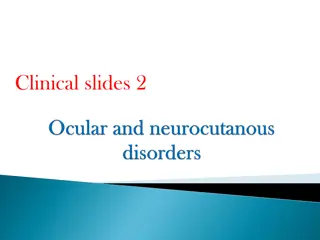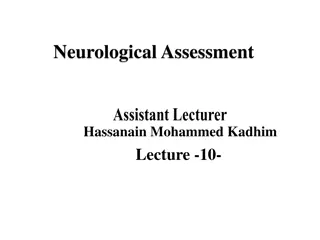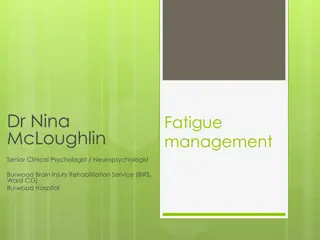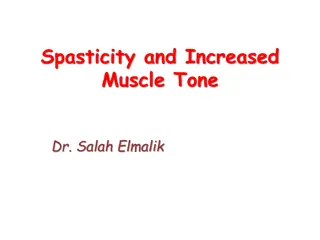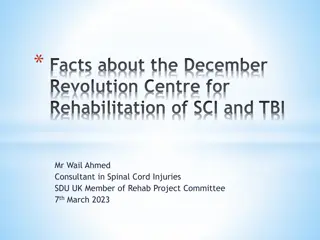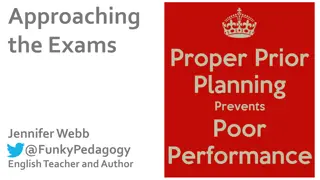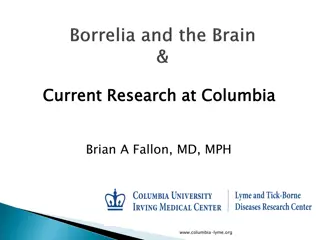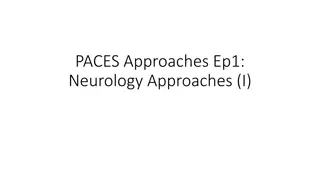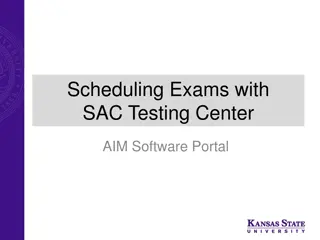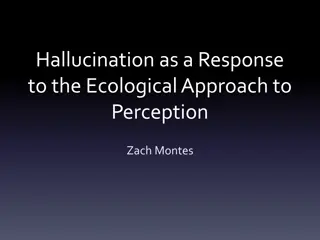Comprehensive Guide to Neurological Exams
This guide provides a detailed overview of neurological exams, focusing on components such as cognition, motor function, and cranial nerves. It covers essential aspects like mental status, reflexes, sensation, and gait assessment. The importance of thorough examination in primary care settings is emphasized, alongside warnings against solely relying on exams without due consideration. Additionally, it discusses the significance of assessing memory, consciousness levels, language, and cognitive functions utilizing tools like MMSE and MOCA.
Download Presentation

Please find below an Image/Link to download the presentation.
The content on the website is provided AS IS for your information and personal use only. It may not be sold, licensed, or shared on other websites without obtaining consent from the author. Download presentation by click this link. If you encounter any issues during the download, it is possible that the publisher has removed the file from their server.
E N D
Presentation Transcript
The Basic Neurological Exam (Part I) Physical Exam Curriculum
Outline Lecture Review a brief version of the complete neurological exam Highlight the highest yield components of the neurological exam Focus on primary care Discuss how to focus a neurological exam based upon symptoms Practice! Ophthalmoscopic exam Any component of the neuro exam
The Well-Visit Neurology Exam Cognition Motor Wakefulness and alertness Orientation Basic language and speech function o Repeating phrases o Naming objects o Following commands (ascertained through rest of exam) Pronator drift Finger tapping Coordination Finger to nose Heel to shin Sensory Cranial nerves Romberg testing Pupillary exam Eye movements Facial strength Palatal elevation Shoulder shrug Tongue movements Gait Normal walk and turn Stand on heels, Stand on toes Tandem gait
The Well-Visit Neurology Exam Cognition Motor Wakefulness and alertness Orientation Basic language and speech function o Repeating phrases o Naming objects o Following commands (ascertained through rest of exam) Please never just do this exam while rotating on neurology You still have to use your brain to figure out the necessary parts of the exam When in doubt, test more and/or refer to neuro Pronator drift Finger tapping DISCLAIMER This is not a rule out neurology exam Please never just do this exam for anyone with neurologic complaints Coordination Finger to nose Heel to shin Sensory Cranial nerves Romberg testing Pupillary exam Eye movements Facial strength Palatal elevation Shoulder shrug Tongue movements Gait Normal walk and turn Stand on heels, Stand on toes Tandem gait
The Complete Neurological Exam Cognition Cranial Nerves Motor Function Deep Tendon Reflexes Sensation Coordination (cerebellar) Gait
Mental Status and Cognition Complete exam includes discussion of: memory Level of consciousness visuospatial processing Alertness executive functioning Language perceptual disturbances Speech thought form/content Attention MMSE: orientation, attention, concentration, memory, language, construction abilities Sn 71-92%, Sp 56-96% not as good in MCI MOCA: useful for detecting mild cognitive impairment (MCI) Sn 90%, Sp 87% Simmons, et al. Evaluation of Suspected Dementia Am Fam Physician. 2011 Oct 15;84(8):895-902.
Mental Status and Cognition Complete exam includes discussion of: memory Level of consciousness visuospatial processing Alertness executive functioning Language perceptual disturbances Speech thought form/content Attention MMSE: orientation, attention, concentration, memory, language, construction abilities Sn 71-92%, Sp 56-96% not as good in MCI MOCA: useful for detecting mild cognitive impairment (MCI) Sn 90%, Sp 87% Simmons, et al. Evaluation of Suspected Dementia Am Fam Physician. 2011 Oct 15;84(8):895-902.
Mental Status and Cognition Screening tests for Dementia Clock Draw (organization/planning) Sn 76%, Sp 81% Verbal Fluency (animal naming) (<15), Sn 88%, Sp 96% Mini-Cognitive Assessment Instrument (Mini-Cog), Sn 76%, Sp 89% Three item recall plus clock draw 0-2: high likelihood of dementia, 3-5: low likelihood of dementia Simmons, et al. Evaluation of Suspected Dementia Am Fam Physician. 2011 Oct 15;84(8):895-902.
The Complete Neurological Exam Cognition Cranial Nerves Motor Function Deep Tendon Reflexes Sensation Coordination (cerebellar) Gait
Cranial Nerves: How do I test? Olfactory: smelling salts Optic: fundoscopic exam, visual fields, visual acuity, pupillary light reflex Oculomotor/Trochlear/Abducens: extraocular movements Trigeminal: sensation across three planes of face (V1, V2, V3), forced bite Facial: close eyes tightly, smile, grimace, puff out cheeks Vestibulocochlear: finger rub, tuning fork tests (Rinne, Weber) Glossopharyngeal/Vagus: gag reflex, ahhh Spinal Accessory: shrug shoulders, turn head Hypoglossal: tongue movement from side to side
Cranial Nerves: How do I test? Olfactory: smelling salts Optic: fundoscopic exam, visual fields, visual acuity, pupillary light reflex Oculomotor/Trochlear/Abducens: extraocular movements Trigeminal: sensation across three planes of face (V1, V2, V3), forced bite Facial: close eyes tightly, smile, grimace, puff out cheeks Vestibulocochlear: finger rub, tuning fork tests (Rinne, Weber) Glossopharyngeal/Vagus: gag reflex, ahhh Spinal Accessory: shrug shoulders, turn head Hypoglossal: tongue movement from side to side
More Details on Extraocular Movement Testing Strength of eye movements testing patients for fullness of eye movements to assess for gaze paresis e.g. abducens nerve palsy, internuclear ophthalmoplegia Examining quality of eye movements Fast saccades Smooth pursuits Examining for nystagmus First test at primary gaze i.e. have the patient stare straight at your finger and observe eye movements. The eyes should not move. Look for nystagmus during and at the end of eye movements Physiologic nystagmus 3-4 beats of lateral beating nystagmus at end gaze (e.g. look all the way to the right) that extinguishes Any other nystagmus is potentially abnormal! Vertical nystagmus is very, very bad and can indicate posterior fossa disease
The Complete Neurological Exam Cognition Cranial Nerves Motor Function Deep Tendon Reflexes Sensation Coordination (cerebellar) Gait
Motor Exam Muscle Bulk: inspection LMN: muscle wasting or atrophy Muscle Tone: resistance to passive movement Increased tone: rachety (cogwheel-->Parkinson s), clasp knife (spasticity-- >UMN), lead pipe (basal ganglia) Decreased tone: indicative of lower motor neuron disease Muscle Strength: graded on scale 0=no movement, 1= flicker, 2=horizontal plane, 3= against gravity, 4= against some resistance, 5=normal Pronator Drift: helps elucidate subtle arm weakness (weaker arm drifts ) Dexterity: finger taps, open/close hand, toe taps slowed movement suggests pyramidal/extrapyramidal issues Note any abnormal movements chorea, tremor
Motor Exam Muscle Bulk: inspection LMN: muscle wasting or atrophy Muscle Tone: resistance to passive movement Increased tone: rachety (cogwheel-->Parkinson s), clasp knife (spasticity-- >UMN), lead pipe (basal ganglia) Decreased tone: indicative of lower motor neuron disease Muscle Strength: graded on scale 0=no movement, 1= flicker, 2=horizontal plane, 3= against gravity, 4= against some resistance, 5=normal Pronator Drift: helps elucidate subtle arm weakness (weaker arm drifts ) Dexterity: finger taps, open/close hand, toe taps slowed movement suggests pyramidal/extrapyramidal issues Note any abnormal movements chorea, tremor
The Complete Neurological Exam Cognition Cranial Nerves Motor Function Deep Tendon Reflexes Sensation Coordination (cerebellar) Gait
Deep Tendon Reflexes Reflexes: Achilles: S1, S2 Patellar: (L2), L3, L4 Biceps: C5, C6 Triceps: (C6), C7, C8 Grading: Absent (0), Reduced (1+), Normal (2+), Brisk (3+), Clonus (4+) Hyperactive reflexes: UMN Brisk reflexes can be normal in young healthy people Reduced reflexes: LMN May be present in radiculopathies and mononeuropathies Babinski/Plantar Response: Normal: flexion of great toe with curling of toes Present: great toe extends and toes fan out <--UMN lesion
The Complete Neurological Exam Cognition Cranial Nerves Motor Function Deep Tendon Reflexes Sensation Coordination (cerebellar) Gait
Sensation Dermatomes: Neuropathies: small-fiber = pain/temp DM large-fiber = vibration/proprioception B12 Modalities: light touch pain and temperature vibratory Proprioception (includes Romberg Test)
Sensation Romberg Testing: Patient stands with eyes closed Positive test: imbalance Where to test If unclear localization, test hands and feet If spinal cord localization is suspected, test for sensory level If spinal cord or nerve root is suspected, test for specific dermatomes
Sensation Romberg Testing: Patient stands with eyes closed Positive test: imbalance Where to test If unclear localization, test hands and feet If spinal cord localization is suspected, test for sensory level If spinal cord or nerve root is suspected, test for specific dermatomes
The Complete Neurological Exam Cognition Cranial Nerves Motor Function Deep Tendon Reflexes Sensation Coordination (cerebellar) Gait
Coordination Involve multiple integrated systems: sensory, vestibular, pyramidal, extrapyramidal, basal ganglia, cerebellum Cerebellum combines proprioception with information from muscles to allow smooth limb/trunk movements Abnormalities results in ataxia (midline lesions cause truncal ataxia) Testing for appendicular ataxia: finger to nose heel to shin rapid alternating movements (rhythmic) Testing for truncal ataxia: stance gait
Coordination Involve multiple integrated systems: sensory, vestibular, pyramidal, extrapyramidal, basal ganglia, cerebellum Cerebellum combines proprioception with information from muscles to allow smooth limb/trunk movements Abnormalities results in ataxia (midline lesions cause truncal ataxia) Testing for appendicular ataxia: finger to nose heel to shin rapid alternating movements (rhythmic) Testing for truncal ataxia: stance gait
Gait Assessment: Speed Stride Length Turning Associated Movements Assess for symmetry Testing: walk and turn, stand on heels/toes, tandem Types of abnormal gaits: Ataxic (cerebellar): wide-based, drunk Gait spasticity (UMN): stiffness Hemiparetic gait: favoring one side Parkinsonian: decreased arm swing, shuffling
Gait Assessment: Speed Stride Length Turning Associated Movements Assess for symmetry Testing: walk and turn, stand on heels/toes, tandem Types of abnormal gaits: Ataxic (cerebellar): wide-based, drunk Gait spasticity (UMN): stiffness Hemiparetic gait: favoring one side Parkinsonian: decreased arm swing, shuffling
The Complete Neurological Exam Cognition Cranial Nerves Motor Function Deep Tendon Reflexes Sensation Coordination (cerebellar) Gait
The Well-Visit Neurology Exam Cognition Motor Wakefulness and alertness Orientation Basic language and speech function o Repeating phrases o Naming objects o Following commands (ascertained through rest of exam) Pronator drift Finger tapping Coordination Finger to nose Heel to shin Sensory Cranial nerves Romberg testing Pupillary exam Eye movements Facial strength Palatal elevation Shoulder shrug Tongue movements Gait Normal walk and turn Stand on heels, Stand on toes Tandem gait
